Gardening tips for park home owners - Part 1
Create impact in small spaces with these gardening tips from two experts
Words by Val Chapman
Photos by Val Chapman and John Chapman
We’ve been out in search of garden creation inspiration for you. A visit to a classic garden to gather ideas – and then a garden centre to discover ways of putting the ideas into practice. Your guide to creating stunning garden designs around your park or holiday home starts here.
Creating gardens for holiday or park homes requires a lot of planning and skill to make the most of small areas.
If you’ve moved to a park home estate from a home with a large garden, you’ll find downsizing your gardening ideas a challenge – which is why we’re starting a new series of gardening tips to help you to make the best of your plot.
And, if you’re creating a garden for your holiday home or lodge, you’ll want to make sure it’s ultra-low maintenance, so that it will pretty much look after itself when you’re not there.
So where to start? I needed to discover inspirational, creative ideas to present on these pages – and I needed some expert advice.
Gardening is a subject that demands knowledge. You can’t bumble along, without skill, without knowing what plants to choose, without the vaguest clue as to how to create something of which to be proud. And, without expert advice, you can’t write about a subject about which you know nothing.
Meet our gardening tips experts
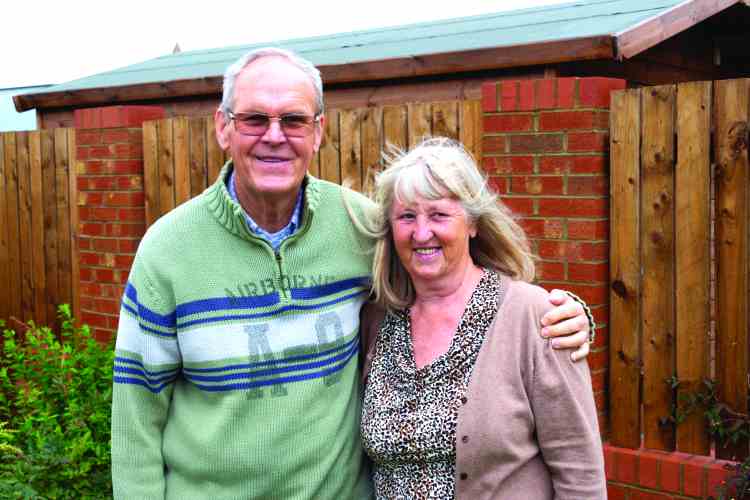
Enter horticultural experts Mick and Kath Wilson.
They are retired now, which is why they have time to spend advising your Editor, whose own garden is a neglected wilderness owing to a work schedule that leaves no time for gardening – and also owing to a complete lack of knowledge. I’m beginning to learn fast, though!
The Wilsons sold their landscape and growing business some years ago, since when they’ve devoted their energies and expertise to creating imaginative and stunning gardens for themselves – and then moved house when they’d their garden was perfect – and then moved house again, to start again.
Garden Number Three since they retired is taking shape nicely now. Garden Number Two has won two trophies, for best garden in its region; that’s where I took these photos.
That garden is a magnificent interlocking web of small, distinctly different areas and
features which come together to create a masterpiece of inspiration. There are rockeries, a little lawn, shale areas for seating, shale areas for pots, meandering pathways created from sea-washed pebbles and crazy paving with inset plants, climbing plants – and, crucially, an amazing array of colour.
Each one of this garden’s individual little areas could be translated into inspiration for even the smallest of garden corners on a park home plot. We’ll be featuring more images from this garden in a future issue of this series.
Seeking out more gardening tips
This amazing garden set me off on a mission to seek out ideas – with the guidance of Mick and Kath.
Wherever you are in Britain there are gardens to visit for inspiration. Kent, Cornwall and Cumbria are three of the counties which are especially rich in formal gardens of a wide variety of types and scales. For the start of this project, though, we could only visit one and it had to be in the northwest because that’s where Mick and Kath live.
Borrowed landscape
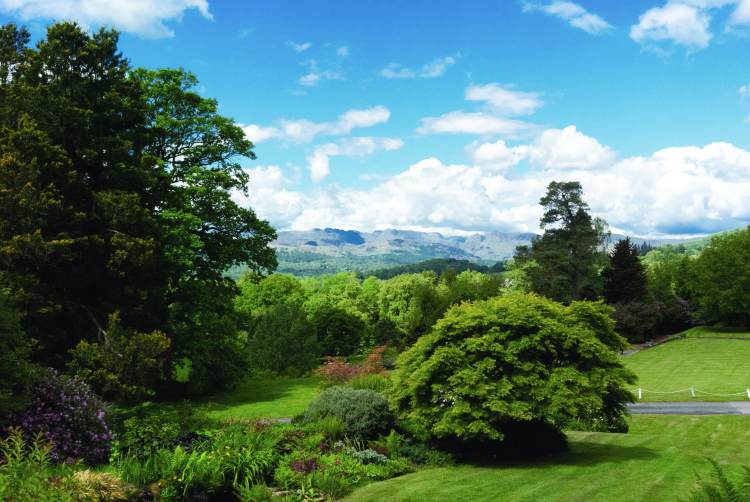
They picked Holehird Gardens, the home of the Lakeland Horticultural Society. It’s in a stunning location overlooking Lake Windermere. It was against that backdrop that I learned my first lesson in garden creation terminology: “Borrowed landscape” – and, with it, the first of several tips of pass on.
Holehird’s amazing location may be an extreme example of the ‘borrowed landscape’ technique, but Mick explained that, when designing a garden, you can make use of any background already there:
“Borrowed landscape is where you allow climbing plants to hide your boundary fence so that you are seeing into the distance rather than your fence stopping the view.”
Translate that into more available locations than the magnificent mountain and lake scenery of Holehird and you are looking at walls and fencing. If you encourage plants to grow up and over fences and walls, you create a background that draws the eye upwards and beyond your garden.
Holehird Gardens, Cumbria
Holehird is entirely run by volunteers and one of them, Publicity Officer Maggie Mees, is our guide for our visit.
“We have 1,600 members, of whom 200 are active volunteers.”
Where do they look for inspiration in creating the many different garden areas at Holehird?
“We have a cool damp climate and we are at 500 feet above sea level on a hillside; we look for plants that will thrive in those conditions.”
And so I learned another lesson – go for plants that will do well in the conditions of your park home garden, be it windswept or sheltered, dry, sunny or in a cool climate with abundant rainfall.
Plants that suit the conditions
“Primulas grow well in damp soil,” Maggie explains as we reach a bed planted with hostas and alliums with other plants interspersed. Himalayan poppies are another; they are large, brilliant blue flowers and quite tall, so make a statement feature in a border.
Plan for all seasons
Maggie explains as she guides us around the garden: “Holehird is a lakeland garden for all seasons – because there is always something to see.“ And that is exactly what most park home gardeners will aspire to – albeit on a comparatively miniscule scale.
Beautiful, feathery astilbe, bold, big, blue meconopsis, big, frondy ferns, daboecia – a summer heather which makes excellent ground cover – are arranged in the bed we’re inspecting and I am learning a whole new vocabulary.
“If you come back in another month the colour will be incredible,” Maggie tells me, again reinforcing the message that gardeners, on whatever scale, should plan for all of the seasons and derive ideas from repeat visits to gardens.
Choosing the right varieties for a soil type is one of the biggest lessons for would-be gardeners, I learn.
Roses aren’t suited to all soil types but “we have proved you can grow them here if you choose the right varieties of rose; shrub roses here do well here,” says Maggie.
We reach a spring meadow ablaze with pale cream and yellow trumpet flowers. Then the rhododendrons – and I spot a peach-coloured rhododendron that I’d never seen before. Rhododendrons are spectacular but will need to be kept well trimmed for a small garden.
Mimic the wild
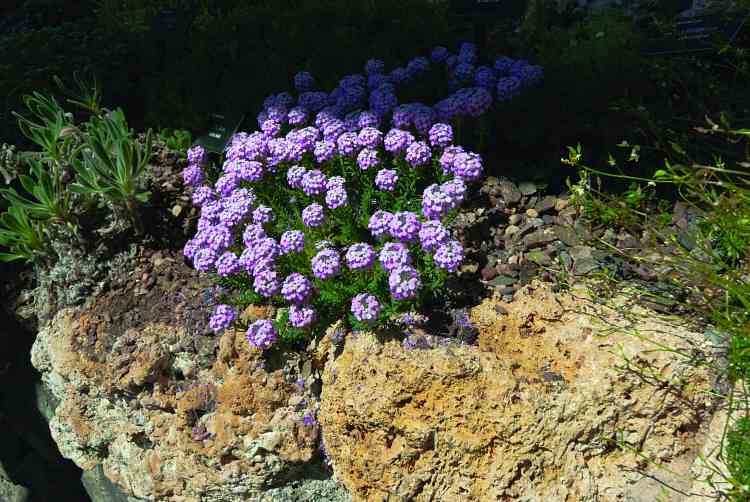
Holehird’s ferns collection is more in line with the inspiration and ideas I’m seeking for small gardens. Here, they’re planted in rockeries. “We’re trying to mimic conditions in the wild,” Maggie explains.
Dry stone walls and banks are numerous in the Lake District and these are the conditions best suited to ferns – damp, but not too wet, and with good drainage, I learn – and that’s another tip to pass on.
A fern catches my eye and adds another word to my new vocabulary. Polystichum, a semi-evergreen fern, is just about at its northern limit in the Lake District, I learn. This is a beautiful fern – it’s mid May and the fronds are just uncurling. The stalks have tinges of orange and the edges of the fronds have a silvery look; another one to add to potential lists for park home rockeries.
Holehird has the National Collection of Polystichum, of which there are three native species in the UK. They like dappled shade, shelter and good drainage. Holehird has them growing in raised stony beds that mimic the shady lanes of Somerset, Devon and Dorset where they thrive. Raised stony beds are so easy to create in a small space.
Rock gardening tips
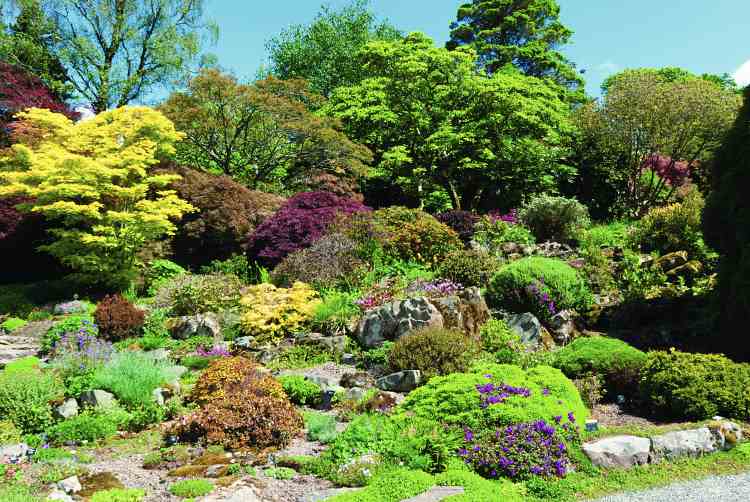
Holehird’s Rock Garden is an especially pertinent source of inspiration for small gardens. And it’s spectacular. Primulas, phlox and geraniums are here to inspire you to create colour in your garden.
Even the smallest of rockeries can have an impact in a park or holiday home garden.
Then I find the Tufa House, a glasshouse display of alpine plants with a rock feature. You don’t have to obtain tufa stone to create this sort of alpine garden but the idea is to get an exceptionally well-drained base, for dianthus, draba, helichrysum and saxifrage, for example.
Spectacular tufa stone’s virtue is that it is very porous. Tufa stone was formed by water rich in calcium flowing over organic material such as mosses and twigs. As the water evaporates the organic material becomes calcified, producing the rough surface of the rock.
If you’re inspired to create this idea using tufa, you can buy tufa stone – visit english-tufa-rock.co.uk
Alpine plants
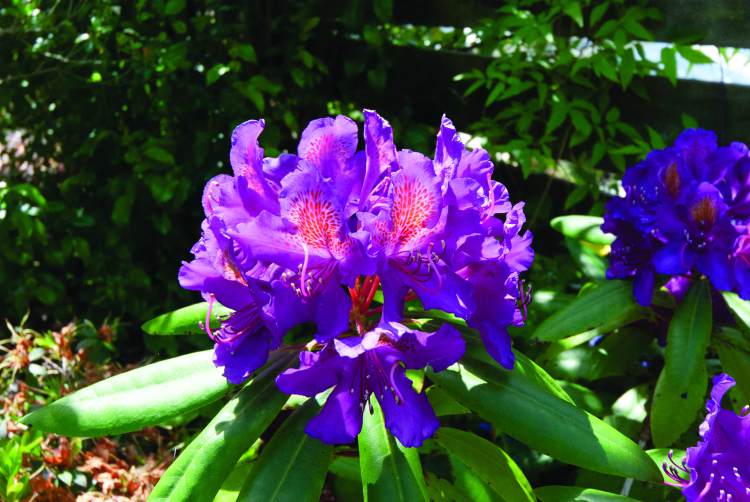
Holehird’s main alpine display house is home to plants that are difficult or impossible to grow outside in the Lake District because they need protection from wet conditions in winter.
Whether you can grow alpine plants in your own garden outside depends on where you are. Ideas I gathered at Holehird are:
- primulas
- sedums
- and helichrysums
form spectacular cushions of miniscule flowers and leaves.
Outside the glasshouse I find more inspiration – a lovely idea for using ground-cover plants on a scree bed; the excellent drainage this method creates mimics alpine conditions of rocky soil – and this idea can easily be presented in a small area.
Watch out for Part Two of our gardening tips series! Subscribe to our e-newsletter here to get the next installment!








Recent Updates
Park home refurbishment: all you need to know
Maintaining the condition of your park home, from its bathroom fittings to the condition of its chassis, is essential to both extending its lifespan ...
A top choice of holiday homes for sale
For your perfect home away from home, take a look at this great selection ...
Park home surveys: all you need to know
For buyers of pre-owned park homes, a survey is vital to make sure the property you're buying is structurally ...
Selling a park home: all you need to know
Selling your park home is rarely an easy decision, so make the process easier with our guide to managing the ...
Park home energy: all you need to know
Make your park home more energy efficient with these tips, helping to save you money and be more ...
Living in a park home: all you need to know
What's it really like to live in a park home? What are the pros and cons, the fees involved and the most ...
Forest retreats: all you need to know
Relax and immerse yourself in nature with a holiday home forest retreat, fusing the community and perks of a ...
Our guide to holiday homes by the sea
If you're interested in buying a holiday home, chances are you're going to look at a coastal holiday park – ...
Holiday homes for all budgets: our guide to mid-level holiday homes
If you are looking for a quality holiday home but don’t want to buy at the top end, the good news is that you ...
Holiday homes for all budgets: our guide to affordable holiday homes
Buying a holiday home on a budget may initially seem a daunting prospect – but there is a lot of choice out ...
Other Articles
Park and holiday home decking: everything you need to know
Decking is a fantastic addition to your holiday home, helping you to enjoy a more outdoorsy lifestyle throughout the summer months on your holiday ...
Park and holiday home finance: everything you need to know
Looking to buy a park or holiday home on finance? While holiday home mortgages are off the table, you can ...
Park home part exchange: what you need to know
Our essential guide for anyone thinking of buying a residential park home using part exchange, including ...
Solar panels for park homes: our advice
If you're considering installing solar panels on your park home, you're far from alone – this growing trend ...
Buying a park home: 10 things to consider
Buying a home on a residential park is a huge and exciting step. Here is our comprehensive guide to making ...
Park home and holiday home chassis: everything you need to know
The chassis underpins the structural integrity of a park home or holiday home. This guide to the essentials ...
Holiday home and park home insurance: your complete guide
Specialist insurance is key to finding the cover most suitable for both park and holiday homes. Read our ...
Park home maintenance advice
Your park home chassis, roof and guttering need to be kept in top condition and older homes may benefit from ...
Park home construction: everything you need to know
A complete guide to park homes, including how and what they are made of ...
Park home paint: how to keep your park home in pristine condition
Our guide to painting your park home and keeping it looking its best ...